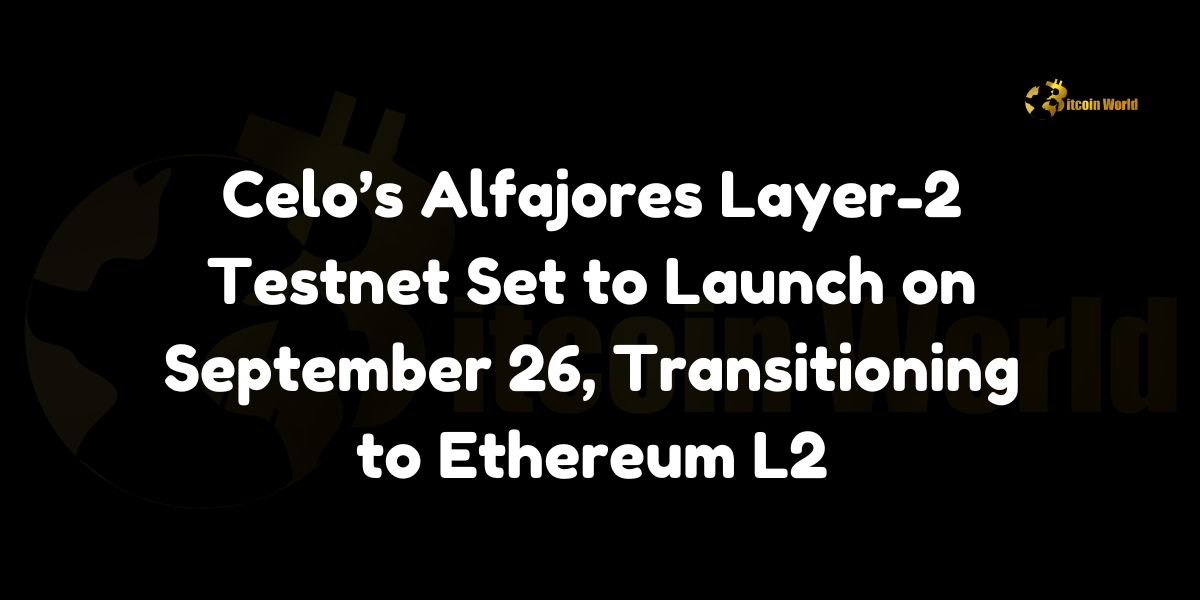Celos Alfajores Layer-2 Testnet Set to Launch on September 26, Transitioning to Ethereum L2: In a significant update for the Celo project, the highly anticipated Alfajores layer-2 (L2) testnet is scheduled to launch via a hardfork on September 26, 2024, according to an announcement from Mariano Cortesi, Head of Engineering at cLabs, on the Celo Forum. This launch marks a major transition for Celo, as the project moves from its existing Alfajores layer-1 (L1) testnet to a more efficient and scalable L2 solution on the Ethereum blockchain.
The shift to a layer-2 solution is a critical step in Celo’s evolution, enabling better scalability, lower fees, and enhanced user experience for decentralized applications (dApps) running on the Celo network. Following the hardfork, the current Alfajores L1 will be permanently shut down, and the Alfajores L2 testnet will become the only active testnet for Celo.
Transitioning Celo to Ethereum Layer-2
The move to layer-2 via the Ethereum blockchain reflects Celo’s commitment to leveraging Ethereum’s security and ecosystem while maintaining the flexibility and features that make Celo unique. By integrating with Ethereum’s L2 infrastructure, Celo aims to provide faster transaction times, lower fees, and more advanced features for developers and users alike.
The Alfajores L2 testnet will support new functionalities that are designed to improve the overall usability of the Celo network. These include innovations such as fee abstraction, which allows users to pay gas fees using ERC-20 tokens like USDC and USDT, and one-block finality, which ensures that transactions are confirmed almost instantly, improving the speed and efficiency of the network.
Key Features of Alfajores Layer-2 Testnet
The launch of Alfajores L2 introduces several important features that are expected to enhance the Celo ecosystem:
- Fee Abstraction: One of the standout features of the new L2 testnet is fee abstraction, which enables users to pay gas fees with ERC-20 tokens such as USDC and USDT. This is a significant improvement over traditional blockchain networks, where gas fees are typically paid in the network’s native token. By allowing ERC-20 tokens to cover gas fees, Celo aims to make the network more user-friendly and accessible, particularly for users who may not be familiar with purchasing and holding native tokens like CELO.
- One-Block Finality: The new testnet will introduce one-block finality, a feature that ensures transactions are confirmed in a single block. This drastically reduces the time it takes to finalize transactions, providing a smoother experience for both users and dApps operating on the Celo network.
- Dual-Use of CELO Token: The CELO token will be used in dual capacities on the L2 testnet. It will continue to function natively as the Celo blockchain’s utility token, while also being compatible as an ERC-20 token within the Ethereum ecosystem. This dual-use functionality allows CELO to bridge the gap between Celo’s decentralized network and Ethereum’s vast ecosystem of tokens and dApps.
- Staking Rewards: Users and validators participating in the Alfajores L2 testnet will also have access to staking rewards. This incentivizes active participation in the network and ensures that validators are rewarded for securing the network while contributing to its growth and security.
- Ultragreen Money Model: The L2 testnet will also implement Celo’s Ultragreen Money model, an innovative approach that aligns with Celo’s mission to support environmental sustainability through blockchain technology. This model incentivizes projects and users who prioritize green initiatives and sustainable practices, further differentiating Celo from other blockchain networks.
Shutdown of Alfajores Layer-1 Testnet
As part of the transition, the existing Alfajores L1 testnet will be permanently shut down following the hardfork. All data and state from the L1 testnet will be transferred to the new Alfajores L2 network, ensuring continuity for developers and users who have been building on the Celo testnet. The move to L2 is expected to bring immediate benefits in terms of scalability, transaction costs, and network efficiency.
The decision to retire the L1 testnet reflects the broader industry trend of adopting layer-2 scaling solutions to overcome the limitations of layer-1 blockchains, particularly around transaction speed and cost. By making L2 the sole active testnet, Celo is positioning itself to better compete with other Ethereum-compatible networks and provide a superior experience for developers and users.
Future of Celo on Ethereum
The integration of Celo into the Ethereum layer-2 ecosystem represents a new chapter for the project, with increased interoperability between Celo and other Ethereum-based projects. This transition allows Celo to tap into Ethereum’s vast network effects, security protocols, and developer community while retaining its own unique focus on financial inclusion and environmental sustainability.
With the September 26 launch date rapidly approaching, the crypto community is closely watching how the Alfajores L2 testnet will perform and what implications it will have for Celo’s mainnet and future development.
Conclusion: A Major Milestone for Celo
The launch of the Alfajores layer-2 testnet is a pivotal moment for the Celo project, as it transitions from a layer-1 network to a scalable layer-2 solution on Ethereum. The new testnet will offer improved functionality, including fee abstraction, one-block finality, and staking rewards, while enhancing the overall usability of the network.
As Celo continues to evolve and integrate more deeply with Ethereum, the project’s commitment to innovation and sustainability will be key factors in its success. The shift to L2 positions Celo as a competitive player in the broader blockchain ecosystem, ready to take advantage of the growing demand for decentralized finance (DeFi) solutions and scalable blockchain infrastructure.
Internal Link Reference
To learn more about the innovative startups shaping the future of the crypto industry, explore our article on the latest news, where we delve into the most promising ventures and their potential to disrupt traditional industries.
Disclaimer: The information provided is not trading advice, Bitcoinworld.co.in holds no liability for any investments made based on the information provided on this page. We strongly recommend independent research and/or consultation with a qualified professional before making any investment decisions.

